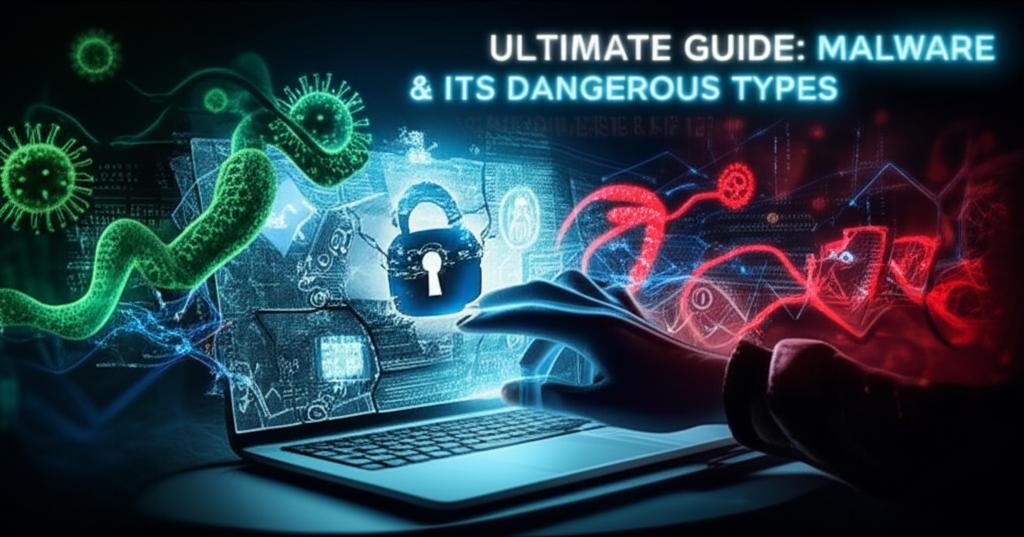The Ultimate Guide: Understanding the Dangerous World of Malware and Its Types
In today’s interconnected digital landscape, understanding the threats that lurk online is paramount. Among the most pervasive and dangerous of these threats is malware. But what exactly is malware, and how does it manifest in its various forms? This comprehensive guide will demystify this critical cybersecurity concept, exploring its definition, common characteristics, and the diverse types of malware you need to be aware of.
What is Malware?
The term “malware” is a portmanteau of “malicious software.” Essentially, malware refers to any software intentionally designed to cause damage, disrupt computer operation, steal sensitive information, or gain unauthorized access to computer systems. It’s an umbrella term encompassing a wide array of hostile or intrusive software, including viruses, worms, Trojans, ransomware, spyware, adware, and more.
Malware can infiltrate your system through various vectors:
- Phishing emails with malicious attachments or links.
- Compromised websites or drive-by downloads.
- Infected USB drives.
- Software vulnerabilities.
- Bundled with legitimate-looking software.
Once inside, malware can perform a range of harmful actions, from slowing down your computer and displaying unwanted ads to encrypting your files for ransom or silently exfiltrating your personal data.
Different Types of Malware
The world of malware is vast and constantly evolving. Here are some of the most common and dangerous types you should know:
1. Viruses
Computer viruses are perhaps the most well-known type of malware. They attach themselves to legitimate programs or documents and require user action (like opening the infected file) to execute. Once activated, a virus can replicate itself, spreading to other programs and files on the host system, and often across networks. Viruses can corrupt data, destroy files, or even completely wipe hard drives.
2. Worms
Unlike viruses, worms are standalone malware programs that can self-replicate and spread independently across networks without needing to attach to a host program or user interaction. They exploit network vulnerabilities to propagate rapidly, consuming bandwidth and system resources, often causing network slowdowns or crashes. Famous examples include the Morris Worm and Stuxnet.
3. Trojan Horses (Trojans)
Named after the ancient Greek tale, a Trojan horse is a type of malware disguised as legitimate software. Users are tricked into downloading and executing Trojans because they appear to be harmless or useful applications. Once installed, Trojans can create backdoors for remote access, steal data, install other malware, or delete files without the user’s knowledge.
4. Ransomware
Ransomware is a particularly destructive type of malware that encrypts a victim’s files or locks their computer system, then demands a ransom (usually in cryptocurrency) in exchange for the decryption key or unlocking the system. If the ransom isn’t paid, the data may be permanently lost. Notable ransomware families include WannaCry, NotPetya, and Ryuk.
5. Spyware
Spyware is malware designed to secretly observe and record user activity without their knowledge or consent. It can track web browsing habits, collect login credentials, monitor keystrokes (keyloggers), and capture sensitive personal information. This data is then typically sent to a remote attacker. Adware can sometimes be considered a form of spyware, as it tracks user habits to deliver targeted advertisements.
6. Adware
Adware, short for “advertising-supported software,” is software that displays unwanted advertisements, often in the form of pop-ups, banners, or redirects. While some adware might be relatively benign, other forms can be intrusive, difficult to remove, and may track user activity, blurring the lines with spyware. It often comes bundled with free software.
7. Rootkits
Rootkits are stealthy types of malware designed to conceal the presence of other malicious software (and themselves) on a computer system. They gain privileged access (root access) to the operating system, allowing attackers to manipulate and hide their activities from detection. Rootkits can be extremely difficult to detect and remove, often requiring specialized tools.
8. Botnets
A botnet is a network of compromised computers (“bots”) controlled by a single attacker (the “bot herder”). Each bot is infected with malware that allows it to be remotely controlled. Botnets are typically used to carry out large-scale malicious activities, such as sending spam, launching distributed denial-of-service (DDoS) attacks, or mining cryptocurrency.
How to Protect Yourself from Malware
Protecting against malware requires a multi-layered approach and constant vigilance:
- Use Reputable Antivirus Software: Keep it updated and run regular scans.
- Keep Software Updated: Patch operating systems, web browsers, and applications to fix security vulnerabilities.
- Be Wary of Phishing: Exercise caution with unsolicited emails, suspicious links, and unexpected attachments.
- Strong Passwords and Multi-Factor Authentication (MFA): Implement robust authentication methods.
- Backup Your Data: Regularly back up important files to an external drive or cloud service.
- Use a Firewall: A firewall monitors and controls incoming and outgoing network traffic.
- Educate Yourself: Understand common threats and best practices for online safety.
Conclusion
Malware remains one of the most significant threats in the digital realm. By understanding what malware is and familiarizing yourself with its various types, you empower yourself to take proactive measures to protect your personal data, devices, and digital well-being. Stay informed, stay vigilant, and practice good cybersecurity hygiene to navigate the dangerous world of malicious software safely.







